springboot와 redis 통합에서 @Cacheable을 사용하는 방법
먼저 캐시 관리자를 구성한 다음 캐시 주석을 사용하여 캐시를 관리할 수 있습니다
package com.cherish.servicebase.handler;
import com.fasterxml.jackson.annotation.JsonAutoDetect;
import com.fasterxml.jackson.annotation.PropertyAccessor;
import com.fasterxml.jackson.databind.ObjectMapper;
import org.springframework.cache.CacheManager;
import org.springframework.cache.annotation.CachingConfigurerSupport;
import org.springframework.cache.annotation.EnableCaching;
import org.springframework.context.annotation.Bean;
import org.springframework.context.annotation.Configuration;
import org.springframework.data.redis.cache.RedisCacheConfiguration;
import org.springframework.data.redis.cache.RedisCacheManager;
import org.springframework.data.redis.connection.RedisConnectionFactory;
import org.springframework.data.redis.core.RedisTemplate;
import org.springframework.data.redis.serializer.Jackson2JsonRedisSerializer;
import org.springframework.data.redis.serializer.RedisSerializationContext;
import org.springframework.data.redis.serializer.RedisSerializer;
import org.springframework.data.redis.serializer.StringRedisSerializer;
import java.time.Duration;
@Configuration
@EnableCaching
public class RedisConfig extends CachingConfigurerSupport {
@Bean
public RedisTemplate<String, Object> redisTemplate(RedisConnectionFactory factory) {
RedisTemplate<String, Object> template = new RedisTemplate<>();
RedisSerializer<String> redisSerializer = new StringRedisSerializer();
Jackson2JsonRedisSerializer jackson2JsonRedisSerializer = new Jackson2JsonRedisSerializer(Object.class);
ObjectMapper om = new ObjectMapper();
om.setVisibility(PropertyAccessor.ALL, JsonAutoDetect.Visibility.ANY);
om.enableDefaultTyping(ObjectMapper.DefaultTyping.NON_FINAL);
jackson2JsonRedisSerializer.setObjectMapper(om);
template.setConnectionFactory(factory);
//key序列化方式
template.setKeySerializer(redisSerializer);
//value序列化
template.setValueSerializer(jackson2JsonRedisSerializer);
//value hashmap序列化
template.setHashValueSerializer(jackson2JsonRedisSerializer);
return template;
}
@Bean
public CacheManager cacheManager(RedisConnectionFactory factory) {
RedisSerializer<String> redisSerializer = new StringRedisSerializer();
Jackson2JsonRedisSerializer jackson2JsonRedisSerializer = new Jackson2JsonRedisSerializer(Object.class);
//解决查询缓存转换异常的问题
ObjectMapper om = new ObjectMapper();
om.setVisibility(PropertyAccessor.ALL, JsonAutoDetect.Visibility.ANY);
om.enableDefaultTyping(ObjectMapper.DefaultTyping.NON_FINAL);
jackson2JsonRedisSerializer.setObjectMapper(om);
// 配置序列化(解决乱码的问题),过期时间600秒
RedisCacheConfiguration config = RedisCacheConfiguration
.defaultCacheConfig()
.entryTtl(Duration.ofSeconds(600))
.serializeKeysWith(RedisSerializationContext.SerializationPair.fromSerializer(redisSerializer))
.serializeValuesWith(RedisSerializationContext.SerializationPair.fromSerializer(jackson2JsonRedisSerializer))
.disableCachingNullValues();
RedisCacheManager cacheManager = RedisCacheManager.builder(factory)
.cacheDefaults(config)
// 可以给每个cacheName不同的RedisCacheConfiguration 设置不同的过期时间
//.withCacheConfiguration("Users",config.entryTtl(Duration.ofSeconds(100)))
.transactionAware()
.build();
return cacheManager;
}
}1. @Cacheable
은 메서드나 클래스에 표시되어 해당 메서드나 클래스가 캐싱을 지원함을 나타냅니다. Spring이 주석 식별 메소드를 호출한 후, 반환 값은 Redis에 캐시되어 다음에 동일한 조건으로 메소드가 호출될 때 반환 값이 캐시에서 직접 얻어질 수 있도록 보장합니다. 이렇게 하면 이 방법의 비즈니스 처리 프로세스를 다시 실행할 필요가 없어 효율성이 향상됩니다.
@Cacheable에서 일반적으로 사용되는 세 가지 매개 변수는 다음과 같습니다.
cacheNames 캐시 이름
캐시 키, 키 쓰기 방법에 주의해야 함
캐시 실행 조건, true가 반환될 때 실행
Example
//查询所有用户,缓存到redis中
@GetMapping("/selectFromRedis")
@Cacheable(cacheNames = "Users",key = "'user'")
public ResultData getUserRedis(){
List<User> list = userService.list(null);
return ResultData.ok().data("User",list);
}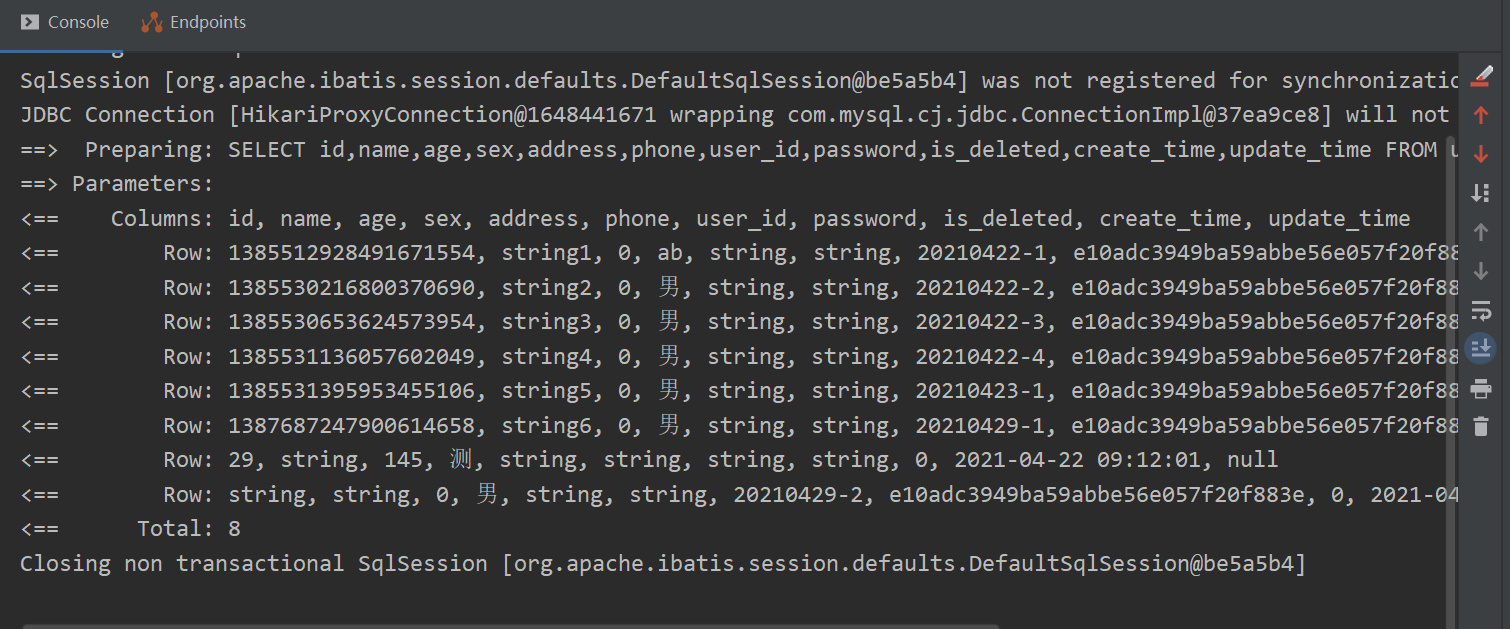
첫 번째 쿼리는 데이터베이스에서 쿼리된 다음 Redis에 캐시됩니다. Redis 시각화 도구를 사용하여 캐시된 정보를 봅니다.
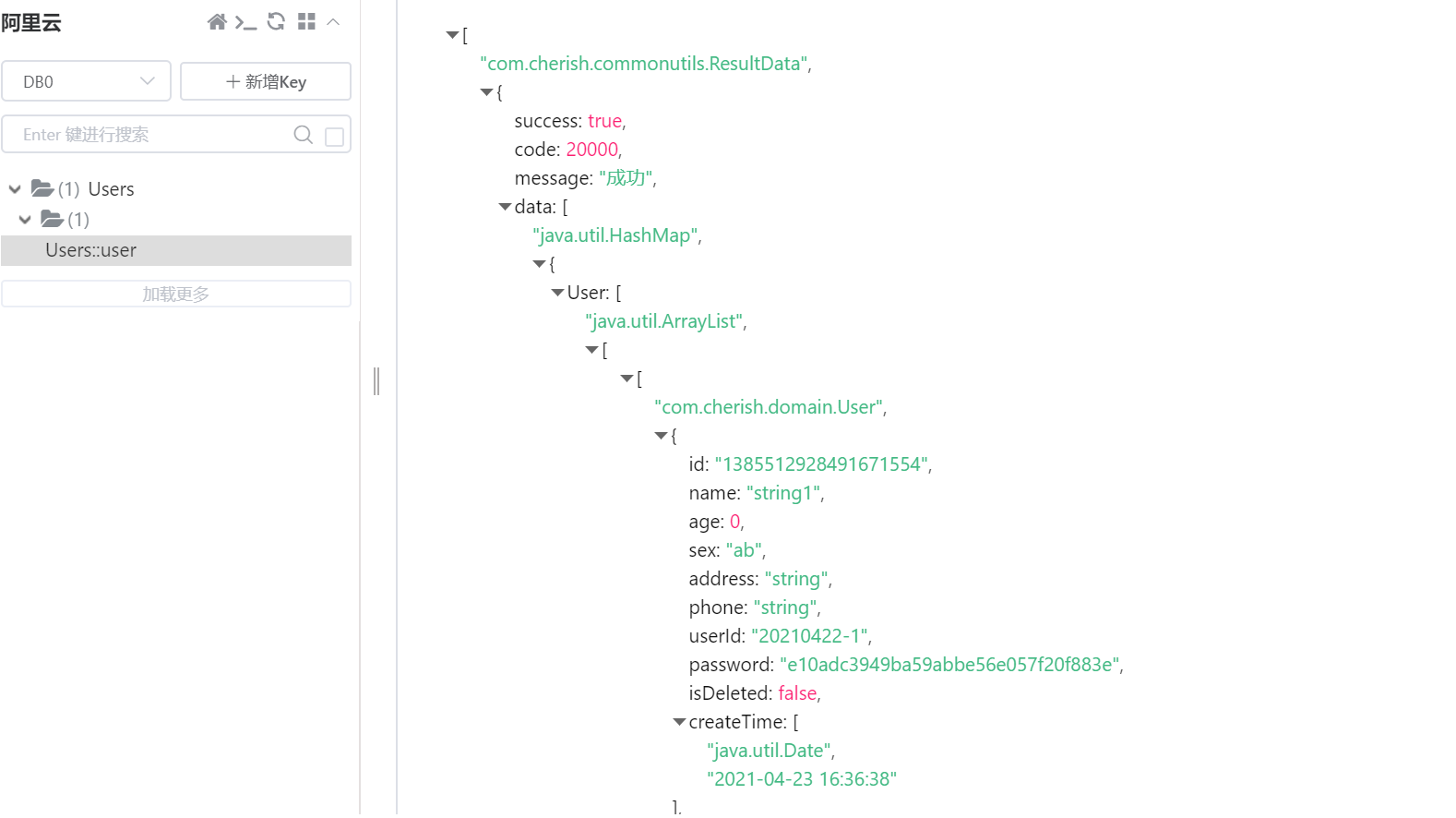
두 번째 쿼리는 캐시 콘솔로 이동합니다. 출력이 없으므로 Redis 캐시는 Redis에서 결과를 가져와 직접 반환하는 것입니다. 메소드에

@CacheEvict
표시가 되어 있으며, 메소드 실행 후 조건이나 키에 따라 해당 캐시가 삭제됩니다. 일반적으로 사용되는 속성:
allEntries 부울 유형, 캐시의 모든 요소를 지워야 하는지 여부를 나타냄
key 삭제해야 하는 캐시된 키
//调用这个接口结束后,删除指定的Redis缓存
@PostMapping("updateUser")
@CacheEvict(cacheNames ="Users",key = "'user'")
public ResultData updateUser(@RequestBody User user){
String id = user.getId();
QueryWrapper<User> wrapper=new QueryWrapper<>();
wrapper.eq("id",id);
boolean b = userService.update(user, wrapper);
return ResultData.ok().data("flag",b);
} //不删除redis缓存
@PostMapping("updateUser2")
public ResultData updateUser2(@RequestBody User user){
String id = user.getId();
QueryWrapper<User> wrapper=new QueryWrapper<>();
wrapper.eq("id",id);
boolean b = userService.update(user, wrapper);
return ResultData.ok().data("flag",b);
}데이터베이스의 데이터를 업데이트할 때, Redis 비어 있음을 캐시해야 합니다. 그렇지 않으면 우리가 쿼리하는 데이터는 Redis Cache의 데이터이므로 데이터베이스와 캐시된 데이터 간에 불일치가 발생합니다.
예: @CacheEvict 주석 없이 인터페이스를 호출하여 데이터를 수정합니다. 쿼리에서 얻은 데이터는 수정 전입니다.
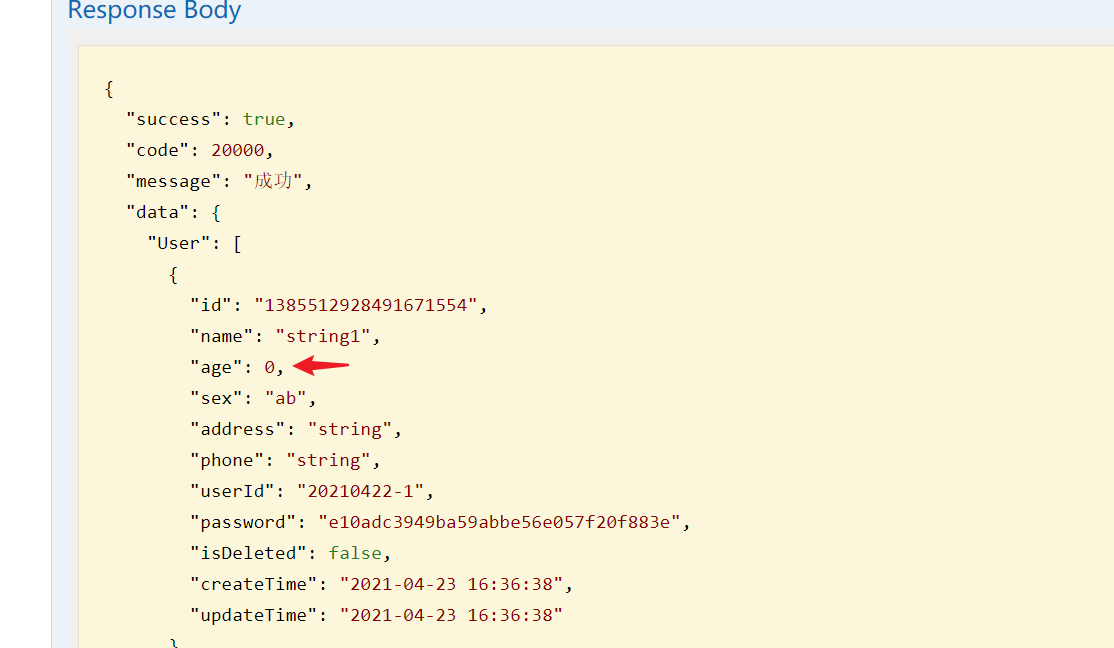
그래서 데이터를 수정하기 위해 인터페이스를 호출할 때 캐시를 지워야 합니다.
해당 캐시를 지우려면 @CacheEvict 주석을 추가하세요. 이때 데이터를 쿼리하면 데이터가 다음과 같습니다. 최신이고 데이터베이스와 일치합니다.
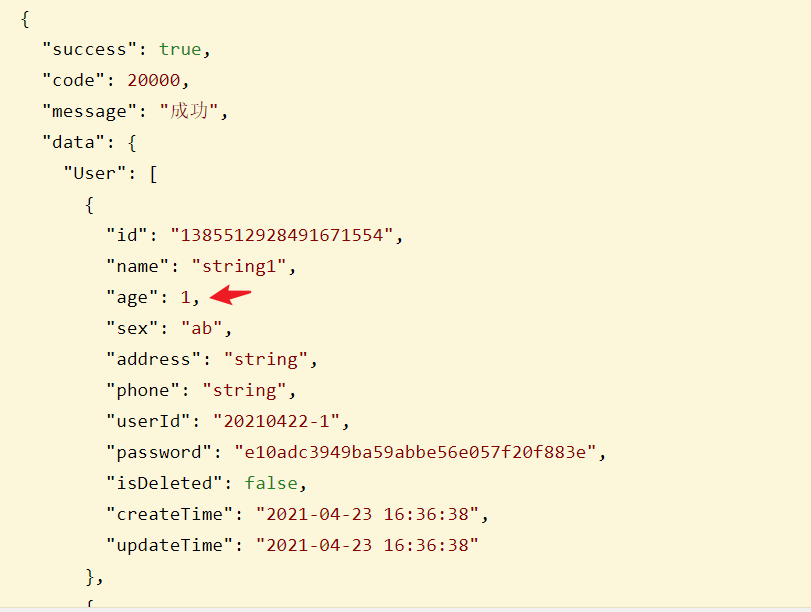
Expiration time
Spring Cache의 기본 기능을 구현하고 Redis를 RedisCacheManger,但众所周知,我们在使用@Cacheableannotation으로 통합했습니다. 이는 캐시에 부여할 수 없는 만료 시간입니다. 그러나 때로는 일부 시나리오에서는 캐시에 만료 시간을 주어야 하는 경우도 있습니다. 이것은 기본 만료 시간입니다
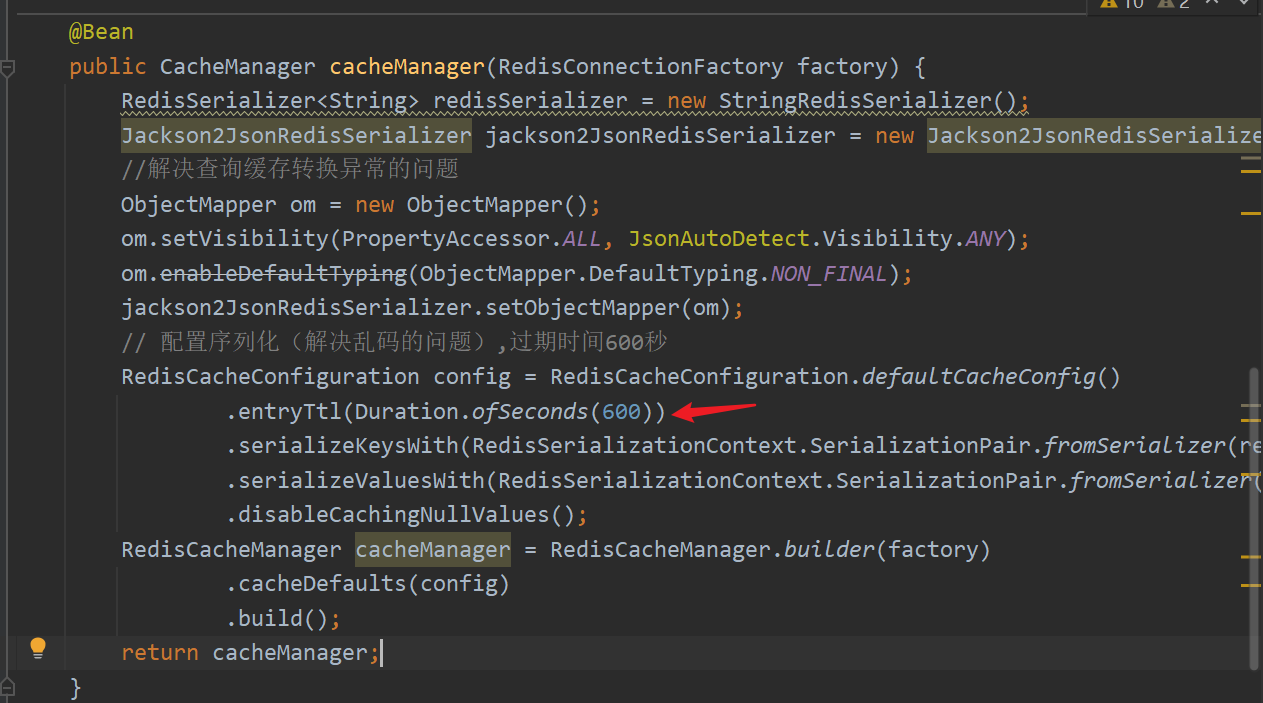
데이터 유효 시간
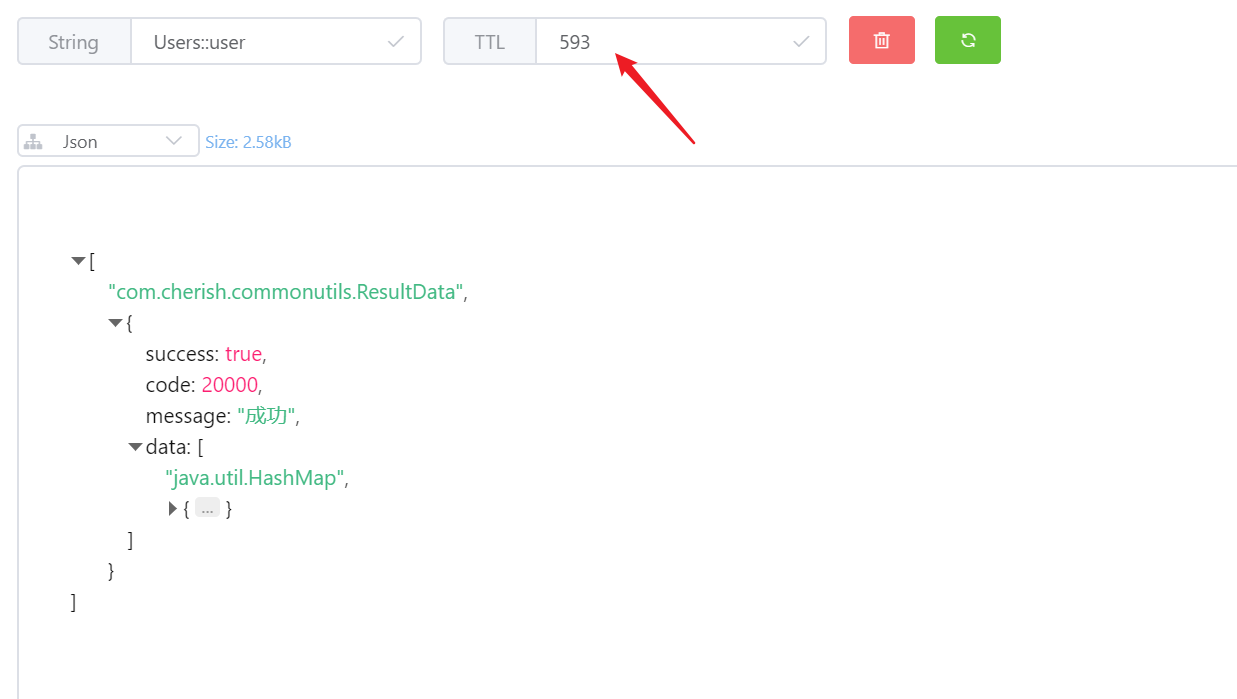
사용자 지정 만료 시간

새 Redis 구성을 사용하고 캐시를 다시 쿼리하여 데이터 유효 기간을 확인하세요
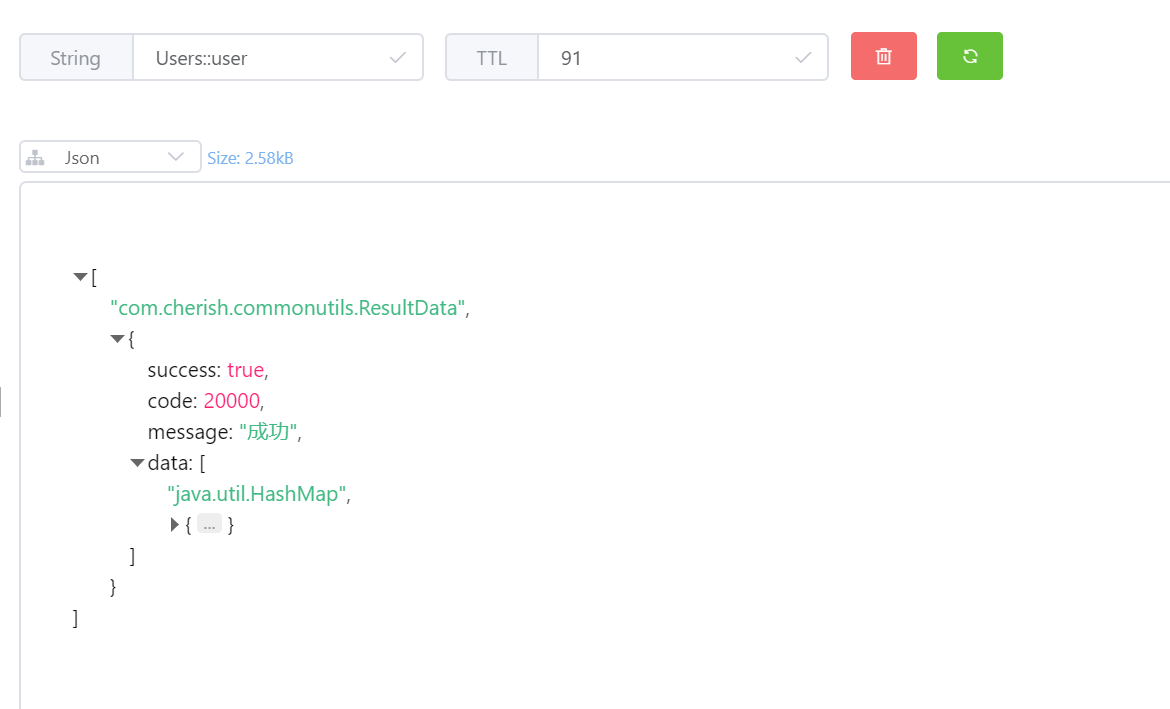
위 내용은 springboot와 redis 통합에서 @Cacheable을 사용하는 방법의 상세 내용입니다. 자세한 내용은 PHP 중국어 웹사이트의 기타 관련 기사를 참조하세요!

핫 AI 도구

Undresser.AI Undress
사실적인 누드 사진을 만들기 위한 AI 기반 앱

AI Clothes Remover
사진에서 옷을 제거하는 온라인 AI 도구입니다.

Undress AI Tool
무료로 이미지를 벗다

Clothoff.io
AI 옷 제거제

AI Hentai Generator
AI Hentai를 무료로 생성하십시오.

인기 기사

뜨거운 도구

메모장++7.3.1
사용하기 쉬운 무료 코드 편집기

SublimeText3 중국어 버전
중국어 버전, 사용하기 매우 쉽습니다.

스튜디오 13.0.1 보내기
강력한 PHP 통합 개발 환경

드림위버 CS6
시각적 웹 개발 도구

SublimeText3 Mac 버전
신 수준의 코드 편집 소프트웨어(SublimeText3)

뜨거운 주제
 7521
7521
 15
15
 1378
1378
 52
52
 81
81
 11
11
 54
54
 19
19
 21
21
 70
70
 Redis 클러스터 모드를 구축하는 방법
Apr 10, 2025 pm 10:15 PM
Redis 클러스터 모드를 구축하는 방법
Apr 10, 2025 pm 10:15 PM
Redis Cluster Mode는 Sharding을 통해 Redis 인스턴스를 여러 서버에 배포하여 확장 성 및 가용성을 향상시킵니다. 시공 단계는 다음과 같습니다. 포트가 다른 홀수 redis 인스턴스를 만듭니다. 3 개의 센티넬 인스턴스를 만들고, Redis 인스턴스 및 장애 조치를 모니터링합니다. Sentinel 구성 파일 구성, Redis 인스턴스 정보 및 장애 조치 설정 모니터링 추가; Redis 인스턴스 구성 파일 구성, 클러스터 모드 활성화 및 클러스터 정보 파일 경로를 지정합니다. 각 redis 인스턴스의 정보를 포함하는 Nodes.conf 파일을 작성합니다. 클러스터를 시작하고 Create 명령을 실행하여 클러스터를 작성하고 복제본 수를 지정하십시오. 클러스터에 로그인하여 클러스터 정보 명령을 실행하여 클러스터 상태를 확인하십시오. 만들다
 Redis 명령을 사용하는 방법
Apr 10, 2025 pm 08:45 PM
Redis 명령을 사용하는 방법
Apr 10, 2025 pm 08:45 PM
Redis 지시 사항을 사용하려면 다음 단계가 필요합니다. Redis 클라이언트를 엽니 다. 명령 (동사 키 값)을 입력하십시오. 필요한 매개 변수를 제공합니다 (명령어마다 다름). 명령을 실행하려면 Enter를 누르십시오. Redis는 작업 결과를 나타내는 응답을 반환합니다 (일반적으로 OK 또는 -err).
 Redis 데이터를 지우는 방법
Apr 10, 2025 pm 10:06 PM
Redis 데이터를 지우는 방법
Apr 10, 2025 pm 10:06 PM
Redis 데이터를 지우는 방법 : Flushall 명령을 사용하여 모든 키 값을 지우십시오. FlushDB 명령을 사용하여 현재 선택한 데이터베이스의 키 값을 지우십시오. 선택을 사용하여 데이터베이스를 전환 한 다음 FlushDB를 사용하여 여러 데이터베이스를 지우십시오. del 명령을 사용하여 특정 키를 삭제하십시오. Redis-Cli 도구를 사용하여 데이터를 지우십시오.
 Redis의 소스 코드를 읽는 방법
Apr 10, 2025 pm 08:27 PM
Redis의 소스 코드를 읽는 방법
Apr 10, 2025 pm 08:27 PM
Redis 소스 코드를 이해하는 가장 좋은 방법은 단계별로 이동하는 것입니다. Redis의 기본 사항에 익숙해집니다. 특정 모듈을 선택하거나 시작점으로 기능합니다. 모듈 또는 함수의 진입 점으로 시작하여 코드를 한 줄씩 봅니다. 함수 호출 체인을 통해 코드를 봅니다. Redis가 사용하는 기본 데이터 구조에 익숙해 지십시오. Redis가 사용하는 알고리즘을 식별하십시오.
 단일 스레드 레 디스를 사용하는 방법
Apr 10, 2025 pm 07:12 PM
단일 스레드 레 디스를 사용하는 방법
Apr 10, 2025 pm 07:12 PM
Redis는 단일 스레드 아키텍처를 사용하여 고성능, 단순성 및 일관성을 제공합니다. 동시성을 향상시키기 위해 I/O 멀티플렉싱, 이벤트 루프, 비 블로킹 I/O 및 공유 메모리를 사용하지만 동시성 제한 제한, 단일 고장 지점 및 쓰기 집약적 인 워크로드에 부적합한 제한이 있습니다.
 Redis 대기열을 읽는 방법
Apr 10, 2025 pm 10:12 PM
Redis 대기열을 읽는 방법
Apr 10, 2025 pm 10:12 PM
Redis의 대기열을 읽으려면 대기열 이름을 얻고 LPOP 명령을 사용하여 요소를 읽고 빈 큐를 처리해야합니다. 특정 단계는 다음과 같습니다. 대기열 이름 가져 오기 : "큐 :"와 같은 "대기열 : my-queue"의 접두사로 이름을 지정하십시오. LPOP 명령을 사용하십시오. 빈 대기열 처리 : 대기열이 비어 있으면 LPOP이 NIL을 반환하고 요소를 읽기 전에 대기열이 존재하는지 확인할 수 있습니다.
 Redis에서 모든 키를 보는 방법
Apr 10, 2025 pm 07:15 PM
Redis에서 모든 키를 보는 방법
Apr 10, 2025 pm 07:15 PM
Redis에서 모든 키를 보려면 세 가지 방법이 있습니다. 키 명령을 사용하여 지정된 패턴과 일치하는 모든 키를 반환하십시오. 스캔 명령을 사용하여 키를 반복하고 키 세트를 반환하십시오. 정보 명령을 사용하여 총 키 수를 얻으십시오.
 Redis로 서버를 시작하는 방법
Apr 10, 2025 pm 08:12 PM
Redis로 서버를 시작하는 방법
Apr 10, 2025 pm 08:12 PM
Redis 서버를 시작하는 단계에는 다음이 포함됩니다. 운영 체제에 따라 Redis 설치. Redis-Server (Linux/MacOS) 또는 Redis-Server.exe (Windows)를 통해 Redis 서비스를 시작하십시오. Redis-Cli Ping (Linux/MacOS) 또는 Redis-Cli.exe Ping (Windows) 명령을 사용하여 서비스 상태를 확인하십시오. Redis-Cli, Python 또는 Node.js와 같은 Redis 클라이언트를 사용하여 서버에 액세스하십시오.




